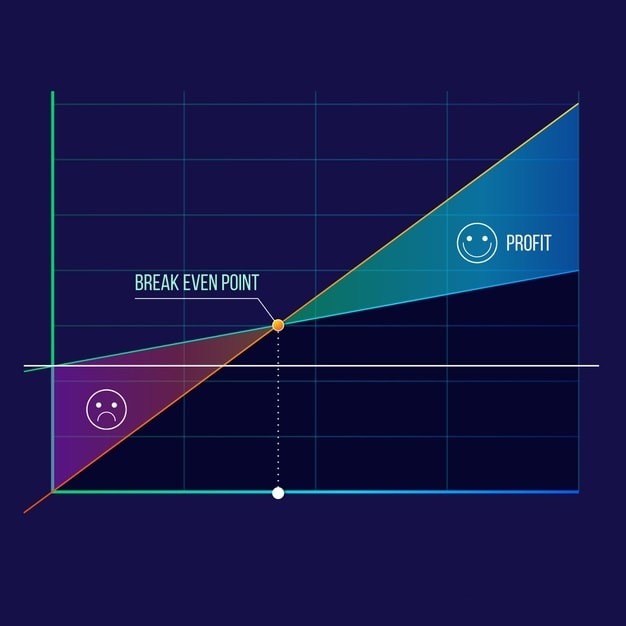Businesses are required to understand the relationship between cost and profit to become successful. As a result of which it becomes crucial for companies to develop pricing strategies in such a way that they can recover their cost and generate profit. Setting too high prices or too low prices can affect the business severely and harm the profitability of the business.
Therefore, companies calculate break-even sales, contribution margins, and net profits to make sure that their business stays profitable. Calculation of these terms helps business to plan their strategies effectively.
In this article, you will learn what break-even analysis is, the formula for calculation of break-even analysis and examples to calculate break-even analysis.
Table of Contents
What is break-even sales?
Break-even sale is a point in sales where companies recover both fixed and variable costs like the cost of supplies, rent of the building & machines, cost of advertising, and salaries & wages of employees.
In simple words, we can say that break-even sales are a point in sales where a company is neither generating profits nor incurring any losses. Break-even sales are calculated by businesses to study the relationship between fixed cost, variable cost, and revenue generated by sales of the products. A company that has low fixed and variable expenses will reach the break-even sales point quickly as compared to the companies with high fixed and variable cost of production.
The following are the essential components that are considered during the calculation of the break, even sales.
1. Fixed cost
The fixed cost occurs as soon as a business thinks about starting an economic activity. The fixed cost is directly associated with the level of production but is not related to the quantity of the output.
The fixed cost is also referred to as overhead cost. Examples of fixed expenses or overhead costs are rent, salaries & wages of employees, depreciation cost, interest paid, taxes, labor cost, and energy cost, etc. These costs are going to be their irrespective of the number of products that you produce in your factory.
For example, if the rent of your building is $10,000 annually, then it is going to be the same if you produce 1000 items or 10,000 items a year.
2. Variable cost
Variable costs are those costs that are directly related to the volume of production. That means the variable cost will decrease with the decrease in the amount of production and will increase when you increase your level of production.
Examples of the variables costs are the cost of raw material used to produce goods, the cost of fuel, the cost of packaging, and other miscellaneous expenses. A person in a business can control these costs according to the demand for the product in the market.
How to Calculate Break-even Sales? Formula
The term break-even sales are used to refer to the point in sales where a company does not make any profit or loss. In simple words, it can be said that break-even sales are the amount earned in the form of revenue by the company that covers all the expenses made by the company for the production of goods.
The formula of break-even sales is derived by dividing the fixed cost with contribution margin percentage.
The formula for calculating break-even sales can be represented as follows:
Break-Even Sales = Fixed costs / Contribution Margin Percentage
Where fixed costs mentioned in the formula are all costs that will take place irrespective of the volume of products such as salaries and wages of employees, rent, taxes, interest, etc.
The contribution percentage can be calculated by dividing the difference between the sales and variable costs with the cost of sales and expressed in the form of a percentage.
The contribution margin percentage can be represented as the following:
Contribution Margin Percentage = ( Total sales – Variable costs) / sales * 100 %
The total sales is the total revenue generated by the sales of the products.
Variable cost is the cost incurred in the production of goods; the variable cost is directly related to the volume of production. Examples of variable expenses are the cost of raw material, labor cost, cost of packaging, etc.
The formula of break-even sales can be created by combining above both formulas.
Break-even Sales = Fixed Costs * sales / Sales – Variable Cost
Examples of calculation of break-even sales
Let us take an example of a company that produces soft toys. The total fixed cost incurred in the production of a certain number of soft toys in the last financial year was $500,000, whereas the variable cost incurred was $1,300,000 on the total sales revenue of $20,00,000 generated by the company. The break-even sales for the company can be calculated using the formula of break-even sales.
Break-even sales = $500,000 * $ 20,00,000 / ( $ 20,00,000 – $1, 300, 000 )
Break-even sales = $1,428, 571
Therefore, the company is required to generate revenue of $1,428,571 in order to cover both variable as well as fixed costs.
Explanation
Let us learn how to break-even sales can be calculated step by step using the formula.
Step 1. Calculate the variable cost of production of the company for which you want to calculate the break-even sales. The variable costs are all those costs that vary with the change in the volume of production—for example, the cost of raw material, labor, and the packaging.
Step 2. In the next step, calculate the fixed cost of production. The fixed expenses are periodic and will occur irrespective of the volume of the output. For example, the company is required to pay salaries of the employees, rent of the building, and taxes, etc.
Step 3. Calculate the total sales made by the company during a particular period, such as annually, half-yearly, etc.
Step 4. In the next step, calculate the contribution margin percentage using the following formula.
Contribution Margin Percentage = ( Total sales – Variable costs) / sales * 100 %
Step 5. In the final step, calculate the break-even sales by dividing fixed costs (calculated in the second step) with the contribution margin percentage (Calculated in the fourth step).
Break-even Sales = Fixed Costs * sales / Contribution margin percentage
OR
Break-even Sales = Fixed costs * Sales / ( Sales – Variable costs )
Benefits of calculating Break-Even sales
1. To catch mixing expenses
It is common for a person in the business to miss on a few miscellaneous expenses. While calculating break-even sales, you are required to review all of your financial expenses. In this way, you can determine all the hidden costs.
2. To decide revenue targets
Once you calculate break-even sales, then you can choose how much revenue you need to generate to stay profitable. In this way, you can determine your sales target accurately.
3. Decide selling price of your products
Choosing the selling price of your product is very important for a business. Calculation of break-even sales helps you in determining the accurate cost of your product.
In this way, you can determine the price of your products in such a way that it is neither too high that your people choose your competitors’ products over your products and nor too low that you will not be able to stay profitable.
4. Make informed decisions
While running a business, you are required to make essential decisions from time to time. Knowing how much you should earn so that your business doesn’t go downhill will help you in making smart decisions.
5. Fund your business
Break-even sales help you in acquiring funds for your business. People look at your business plan before investing their money into your business. Break-even analysis will help you in preparing your business plan.
Liked this post? Check out the complete series on Sales



